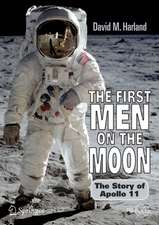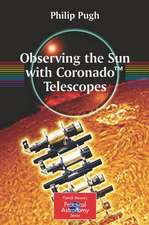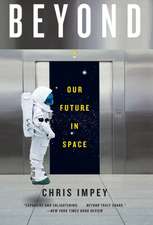Galaxy Collisions: Forging New Worlds from Cosmic Crashes: Springer Praxis Books
Autor Curtis Strucken Limba Engleză Paperback – 3 feb 2011
Din seria Springer Praxis Books
-
 Preț: 294.46 lei
Preț: 294.46 lei -
 Preț: 223.45 lei
Preț: 223.45 lei -
 Preț: 193.12 lei
Preț: 193.12 lei -
 Preț: 167.85 lei
Preț: 167.85 lei -
 Preț: 288.98 lei
Preț: 288.98 lei -
 Preț: 323.74 lei
Preț: 323.74 lei -
 Preț: 376.08 lei
Preț: 376.08 lei -
 Preț: 264.12 lei
Preț: 264.12 lei - 8%
 Preț: 517.61 lei
Preț: 517.61 lei -
 Preț: 190.01 lei
Preț: 190.01 lei -
 Preț: 218.16 lei
Preț: 218.16 lei -
 Preț: 312.06 lei
Preț: 312.06 lei - 17%
 Preț: 401.17 lei
Preț: 401.17 lei -
 Preț: 216.41 lei
Preț: 216.41 lei -
 Preț: 262.27 lei
Preț: 262.27 lei -
 Preț: 264.35 lei
Preț: 264.35 lei -
 Preț: 167.63 lei
Preț: 167.63 lei -
 Preț: 259.52 lei
Preț: 259.52 lei -
 Preț: 259.08 lei
Preț: 259.08 lei -
 Preț: 305.47 lei
Preț: 305.47 lei -
 Preț: 234.01 lei
Preț: 234.01 lei -
 Preț: 227.85 lei
Preț: 227.85 lei -
 Preț: 259.95 lei
Preț: 259.95 lei -
 Preț: 295.56 lei
Preț: 295.56 lei -
 Preț: 357.17 lei
Preț: 357.17 lei -
 Preț: 275.79 lei
Preț: 275.79 lei -
 Preț: 257.08 lei
Preț: 257.08 lei -
 Preț: 349.71 lei
Preț: 349.71 lei -
 Preț: 272.45 lei
Preț: 272.45 lei -
 Preț: 270.27 lei
Preț: 270.27 lei - 8%
 Preț: 433.24 lei
Preț: 433.24 lei -
 Preț: 327.03 lei
Preț: 327.03 lei - 8%
 Preț: 394.80 lei
Preț: 394.80 lei -
 Preț: 320.65 lei
Preț: 320.65 lei -
 Preț: 325.29 lei
Preț: 325.29 lei -
 Preț: 253.11 lei
Preț: 253.11 lei -
 Preț: 192.86 lei
Preț: 192.86 lei -
 Preț: 313.40 lei
Preț: 313.40 lei -
 Preț: 150.51 lei
Preț: 150.51 lei -
 Preț: 233.34 lei
Preț: 233.34 lei -
 Preț: 286.78 lei
Preț: 286.78 lei -
 Preț: 212.01 lei
Preț: 212.01 lei -
 Preț: 366.83 lei
Preț: 366.83 lei -
 Preț: 274.68 lei
Preț: 274.68 lei -
 Preț: 232.27 lei
Preț: 232.27 lei -
 Preț: 284.58 lei
Preț: 284.58 lei -
 Preț: 212.45 lei
Preț: 212.45 lei -
 Preț: 159.81 lei
Preț: 159.81 lei -
 Preț: 349.48 lei
Preț: 349.48 lei - 20%
 Preț: 2061.61 lei
Preț: 2061.61 lei
Preț: 225.19 lei
Nou
Puncte Express: 338
Preț estimativ în valută:
43.10€ • 44.94$ • 35.82£
43.10€ • 44.94$ • 35.82£
Carte disponibilă
Livrare economică 28 februarie-14 martie
Preluare comenzi: 021 569.72.76
Specificații
ISBN-13: 9780387853703
ISBN-10: 0387853707
Pagini: 285
Ilustrații: XV, 285 p.
Dimensiuni: 168 x 240 x 25 mm
Greutate: 0.68 kg
Ediția:2011
Editura: Springer
Colecția Springer
Seriile Springer Praxis Books, Popular Astronomy
Locul publicării:New York, NY, United States
ISBN-10: 0387853707
Pagini: 285
Ilustrații: XV, 285 p.
Dimensiuni: 168 x 240 x 25 mm
Greutate: 0.68 kg
Ediția:2011
Editura: Springer
Colecția Springer
Seriile Springer Praxis Books, Popular Astronomy
Locul publicării:New York, NY, United States
Public țintă
Popular/generalCuprins
Preface.- Acknowledgments.- List of Illustrations.- Chapter1: Exploring the world of galaxies.- Chapter 2: Head-on collisions and rings of fire.- Chapter 3: Swinging on by: the tidal twists.- Chapter 4: Major mergers and their colossal consequences.- Chapter 5: What happens to the little guy: minor mergers.- Chapter 6: The secret of fire: triggered star formation.- Chapter 7: Not always in a galaxy far, far away.- Chapter 8: A wider view.- Chapter 9: Epilogue: the galacto-biology of collisions.- Glossary.- Resources.- Index.
Recenzii
From the reviews:
“Galaxy Collisions is big book, not physically but conceptually. … Colour images, some appropriately from the Hubble Space Telescope, and diagrams support the text where needed throughout. … it is refreshing to read a book that stays strictly on topic. … Where an explanation is required to ensure understanding it is given quickly then attention is swiftly refocused back to the main subject. … reader who has a good understanding of the key concepts of Astronomy will get a lot from this book … .” (Paul Rumsby, Best Astronomy Books, August, 2011)
“This latest book in Springer’s Popular Astronomy series tackles the phenomenon of galaxy collisions. … the author keeps his descriptions qualitative and masterfully so, meaning the book will also appeal if you’re an advanced amateur. With an emphasis on the historical development of the field and some colourful analogies, Struck has managed to produce an entertaining and comprehensive book about this important aspect of modern astronomy.” (Alastair Gunn, Sky at Night Magazine, October, 2011)
“The book, profusely illustrated with many color photographs, is intended for professional scientists, as it quotes and discusses research papers by those active in the field. … This will likely be a valuable resource for scholars currently conducting research in this area. Summing Up: Recommended. Researchers/faculty and professionals.” (A. R. Upgren, Choice, Vol. 49 (2), October, 2011)
“The book is clearly a labour of love by author Curtis Struck, a long-time researcher into galaxy collisions, who attempts to put across his fascination with these events to a wider readership. … it provides the opportunity to showcase the many wonderful images (from HST and elsewhere) of interacting systems.” (Steve Phillipps, The Observatory, Vol. 131 (1225), December, 2011)
“Galaxy Collisions is big book, not physically but conceptually. … Colour images, some appropriately from the Hubble Space Telescope, and diagrams support the text where needed throughout. … it is refreshing to read a book that stays strictly on topic. … Where an explanation is required to ensure understanding it is given quickly then attention is swiftly refocused back to the main subject. … reader who has a good understanding of the key concepts of Astronomy will get a lot from this book … .” (Paul Rumsby, Best Astronomy Books, August, 2011)
“This latest book in Springer’s Popular Astronomy series tackles the phenomenon of galaxy collisions. … the author keeps his descriptions qualitative and masterfully so, meaning the book will also appeal if you’re an advanced amateur. With an emphasis on the historical development of the field and some colourful analogies, Struck has managed to produce an entertaining and comprehensive book about this important aspect of modern astronomy.” (Alastair Gunn, Sky at Night Magazine, October, 2011)
“The book, profusely illustrated with many color photographs, is intended for professional scientists, as it quotes and discusses research papers by those active in the field. … This will likely be a valuable resource for scholars currently conducting research in this area. Summing Up: Recommended. Researchers/faculty and professionals.” (A. R. Upgren, Choice, Vol. 49 (2), October, 2011)
“The book is clearly a labour of love by author Curtis Struck, a long-time researcher into galaxy collisions, who attempts to put across his fascination with these events to a wider readership. … it provides the opportunity to showcase the many wonderful images (from HST and elsewhere) of interacting systems.” (Steve Phillipps, The Observatory, Vol. 131 (1225), December, 2011)
Notă biografică
Professor Curtis Struck has worked in the field of galaxy collisions since his graduate studies in the late 1970's. He has published more than 50 refereed journal papers, the majority in this area, and many as first author. He has spoken at a number of international research conferences and given many public talks.
Struck is a theorist and computer modeler and has worked with many observers on the interpretation of data on colliding galaxies in all wavebands, except gamma-ray. This includes ground-based optical and radio data, and data from NASA's Hubble, Chandra, Spitzer, and GALEX space observatiories.
Struck is a theorist and computer modeler and has worked with many observers on the interpretation of data on colliding galaxies in all wavebands, except gamma-ray. This includes ground-based optical and radio data, and data from NASA's Hubble, Chandra, Spitzer, and GALEX space observatiories.
Textul de pe ultima copertă
Galaxy collisions are the key process in building galaxies, triggering the formation of stars and the build-up of heavy elements that allow the formation of planets and solar systems. This book presents the revolutionary research advances achieved in the last decade and lucidly explains the underlying dynamical processes.
Galaxy Collisions
Galaxy Collisions
- takes a comprehensive trip through the visually spectacular world of galaxy collisions;
- investigates the interactions of stars, gas clouds, and dark matter in galaxy collisions;
- uses analogies and metaphors to help comprehend the bizarre world of galaxies;
- presents recent research results to enhance the understanding of galaxy formation and evolution;
- includes discoveries of minor collisions within our own group of galaxies;
- shows how a galaxy collision might affect a solar system, or a planet like ours.
Caracteristici
Takes a comprehensive trip through the visually spectacular world of galaxy collisions Describes what happens in galaxy collisions in a non-technical way Uses analogies and metaphors to help understand the bizarre world of galaxies Includes discoveries of minor collisions within our own group of galaxies Includes supplementary material: sn.pub/extras







